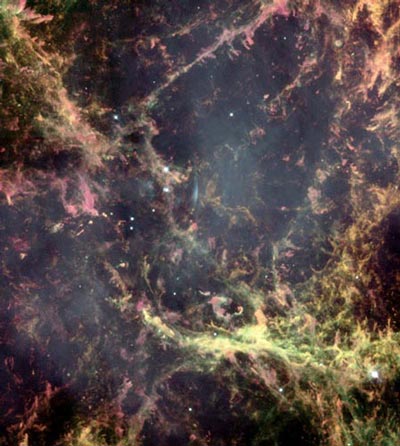Explanation: The supernova explosion that formed the Crab Nebula was first seen on the year 1054. Last week, astronomers released a new image of the still-evolving center of the explosion. The above representative-color photograph was taken in colors emitted by specific elements including hydrogen (orange), nitrogen (red), sulfur (pink), and oxygen (green), with the result appearing oddly similar to a Jackson Pollock painting. Visible is a complex array of gas filaments rushing out at over 5 million kilometers per hour. Even at these tremendous speeds, though, it takes a filament over 600 years to cross the 3 light year wide frame. The rapidly spinning neutron star remnant of this ancient cataclysm is visible as the lower of the two bright stars just above the photograph center. The Crab Nebula (M1) is located 6,500 light-years away towards the constellation of Taurus.
1999 2000 2001 2002 2003 2004 2005 2006 2007 2008 2009 2010 2011 2012 2013 2014 2015 2016 2017 2018 2019 2020 2021 2022 2023 2024 2025 |
Yanvar' Fevral' Mart Aprel' Mai Iyun' Iyul' Avgust Sentyabr' Oktyabr' Noyabr' Dekabr' |
NASA Web Site Statements, Warnings, and Disclaimers
NASA Official: Jay Norris. Specific rights apply.
A service of: LHEA at NASA / GSFC
& Michigan Tech. U.
|
Publikacii s klyuchevymi slovami:
volokna - neitronnye zvezdy - filament - Crab Nebula - Krabovidnaya tumannost' - neutron star
Publikacii so slovami: volokna - neitronnye zvezdy - filament - Crab Nebula - Krabovidnaya tumannost' - neutron star | |
Sm. takzhe:
Vse publikacii na tu zhe temu >> | |
